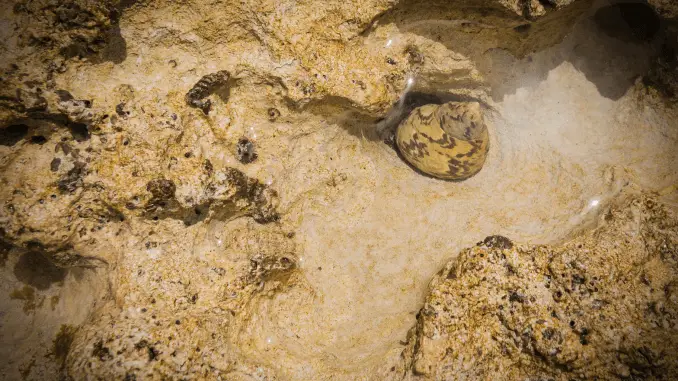
The nerite snail is a species of the Neritidae family, that can live in freshwater and saltwater. These tiny snails are less than 1 inch long and are a beneficial addition to any tank, thanks to their cleaning abilities.
Nerite snails are popular with fishkeeping beginners because these snails are easy to look after and have a peaceful temperament. Their minimal tank requirements and care needs make these snails desirable pets.
TABLE OF CONTENTS
Nerite Snails Facts & Overview
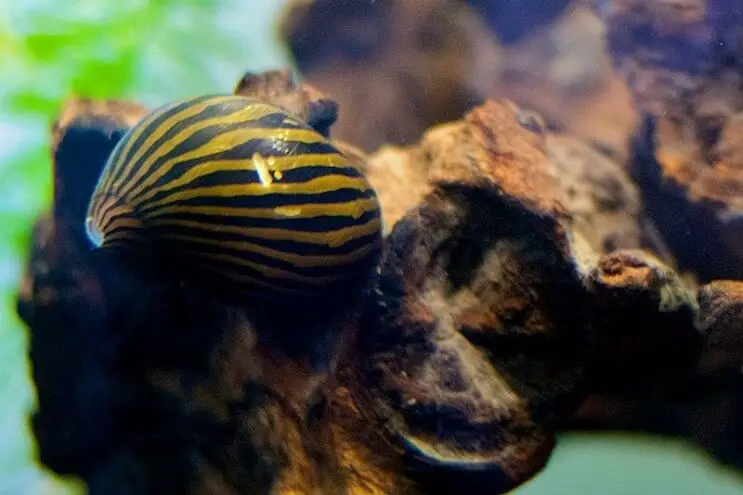
| Scientific name: | Vittina natalensis |
| Common names | Nerite snail, spotted nerite |
| Distribution: | Eastern Africa |
| Size: | 1 inch |
| Life expectancy: | 1–2 years |
| Color: | Various |
| Diet: | Herbivore |
| Temperament: | Peaceful |
| Minimum tank size: | 5 gallons |
| Temperature: | 72–78°F (22–25°C) |
| pH: | 8.0–8.4 |
| Hardness: | 6.0–12.0 dGH (freshwater) 15.0–18.0 dGH (saltwater) |
| Care level: | Easy |
Origin
The nerite snail is typically found in Eastern Africa where it inhabits a mix of saltwater from the sea and freshwater from rivers. Saltwater varieties of nerite snails live on the Caribbean or Pacific coast.
Adult Size & Lifespan
Adult nerite snails measure around 1 inch long, with females typically slightly larger than males. Different species of nerite snails have different shell colors and patterns, but all species are the same size. Healthy nerite snails live up to two years.
Availability
Nerite snails are readily available at most pet stores that specialize in aquatic creatures. This snail species is cheap, typically costing up to $4, but you can expect to pay less per snail if you buy a few at once.
This tank-cleaning invertebrate is available online at Flip Aquatics and LiveAquaria.
Appearance & Behavior
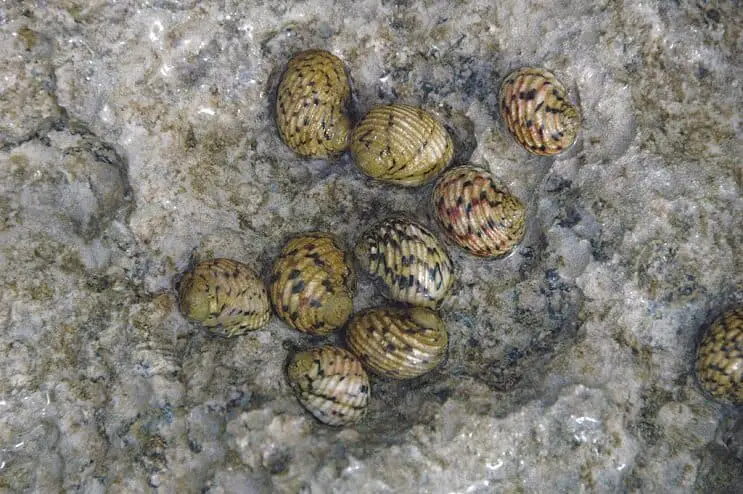
Nerite snails can be striped, horned, or solid-colored. These invertebrates are peaceful and unlikely to behave aggressively towards their tankmates.
Colors, Patterns, and Size
Nerite snails have a large shell that comes in various colors and hides a foot that the snails use to move. Most nerite snails grow to around 1 inch long, with females growing slightly longer than males.
- Zebra nerite snails — Have yellow or black stripes across their shells, pointing towards the center of the coil
- Olive nerite snails — Are a solid olive color. This species of nerite snail is prevalent among aquarists
- Tiger nerite snails — Have stripes similar to the zebra nerite species, but the stripes are orange, resulting in a look similar to a tiger’s coat
- Horned nerite snails — Have black and yellow stripes with a series of spiky horns along one stripe
- Red racer nerite snails — Are bright red (or sometimes yellow) with a stripe running down the middle of their shells. This species of nerite snail is a colorful addition to any aquarist’s tank
Typical Behavior
Nerite snails are peaceful herbivores that tend not to bother their tankmates. As a result of their gentle nature and small size, they can become prey to large, aggressive fish.
The snails are slow movers that spend most of their time consuming tank algae in captivity. These invertebrates are skilled climbers, so they sometimes escape from the tank. Invest in a tight-fitting lid for your tank to avoid your nerite snail escaping.
Nerite Snail Tank & Water Requirements
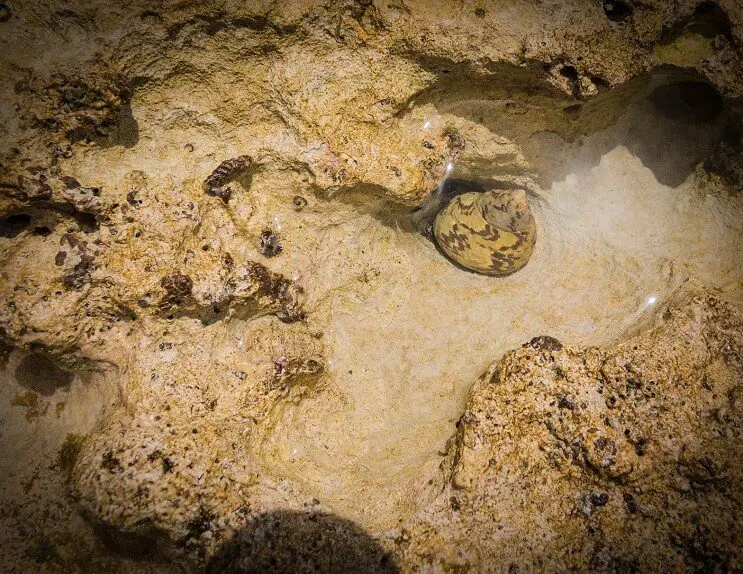
One nerite snail requires a 5-gallon tank, and the more snails you have, the bigger the tank should be. Allow 5 gallons for each snail.
These snails can live in saltwater and freshwater, but they can only breed in saltwater.
Habitat and Tank Requirements
Nerite snails occasionally come to the water’s surface, so keep the tank water a couple of inches below the tank lid to give your snail this option.
Nerite snails are sensitive to very bright light, so use low to moderate lighting for your snail’s tank. Avoid exposing the tank to direct sunlight because this can dry out the snail.
Add rocks to the tank to encourage algae growth, which will give the snails something to eat. Aquarists should wait to add nerite snails to their tanks until a moderate amount of algae has grown in the tank.
Many of the nerite snail’s requirements depend on whether they are kept in salt water or fresh water. Freshwater tanks should have a substrate of mud or dark sand, and saltwater tanks should have calcium sand. The high calcium substrate will encourage healthy shell growth. Hard, scratchy substrate can damage the snail’s soft body, so avoid using hard substrate in the tank.
Water Conditions
| Water type: | Freshwater or saltwater |
| Tank size: | 5 gallons per snail |
| Water temperature: | 72–78°F (22–25°C) |
| Substrate: | Soft sand or mud |
| Acidity: | 8.0–8.4 |
| Water hardness: | 6.0–12.0 dGH (freshwater) 15.0–18.0 dGH (saltwater) |
| Lighting: | Moderate lighting, no sunlight |
| Water supplements: | Calcium |
Water conditions vary slightly depending on whether you’re keeping your snail in freshwater or saltwater, but the tank size, temperature, and pH level should stay the same.
Saltwater tanks require the addition of marine salts to keep the water hard. Keep your nerite snail’s water free from ammonia and nitrate for maximum health.
Care & Diet
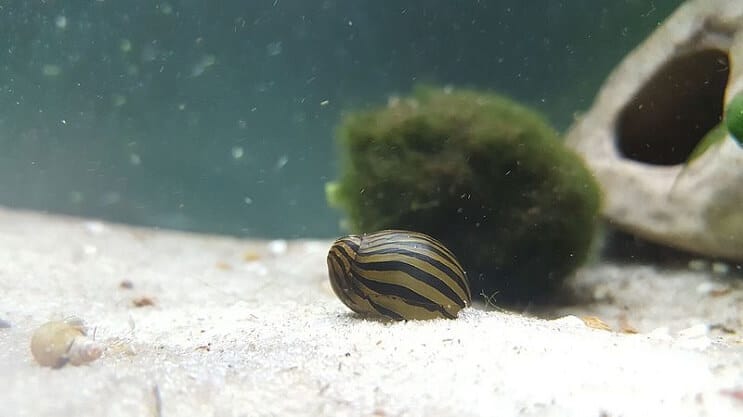
Caring for nerite snails is relatively easy, so they’re suitable for fishkeeping beginners. These snails benefit from eating calcium-rich foods including green leafy vegetables. These small snails tend to be healthy, but common health problems typically affect their shells.
Diet and Feeding
Nerite snails have minimal feeding requirements because their diets mostly consist of the algae in the tank.
However, if the tank is running out of algae for the snail to eat, add spinach, lettuce, and kale to the tank. If you notice the algae stops disappearing from the tank, reduce the amount of vegetables you feed your snail until it returns to eating the algae.
Avoid overfeeding or underfeeding your snail because imbalance can cause health issues. You should be able to judge the amount of vegetables your snail needs based on the amount of algae in the tank.
General Care
Thanks to the nerite snail’s minimal food requirements and adaptability to different water conditions, this species is relatively easy to care for. This species benefits from calcium supplements that keep their shells hard, and minimal lighting to avoid damage from bright lights. Replicate the nerite snail’s natural habitat with rocks for it to hide under and eat algae from.
Common Problems
Nerite snails are generally healthy but they are prone to certain health issues.
If your nerite snail overeats, its shell will become discolored. The discoloration is a sign to stop feeding your snail vegetables and reduce its diet to just the algae in the tank.
If your snail’s shell is cracked or damaged, this is a sign that the shell isn’t strong enough. Strengthen the shell by adding calcium supplements to the tank.
Older snails are prone to edema, which can restrict the snail’s movement. Unfortunately, there’s no treatment for this edema, so give your snail the best comfort and quality of life to minimize discomfort.
Copper is toxic to most invertebrates, so never use copper in the nerite snail’s tank.
Is a Nerite Snail Dangerous?
A nerite snail is a peaceful creature, so fishkeepers can handle it safely. Avoid pulling on the snail’s shell too hard or you could injure the snail.
Breeding
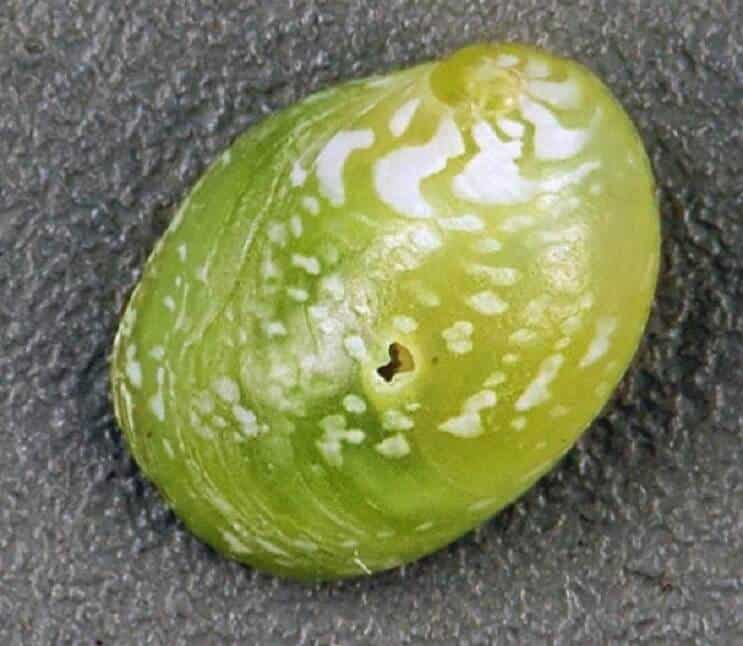
Unlike other snails, nerite snails don’t reproduce asexually. Instead, female nerite snails lay eggs that males then fertilize.
Nerite snails can breed in freshwater tanks, but the eggs won’t hatch because the larvae need brackish water to survive. You’ll need to put your nerite snails, or the eggs, in brackish or salty water for successful breeding. You can either move the eggs to a tank with brackish water or breed with snails that are already accustomed to and kept in a saltwater tank.
There’s little you can do to force nerite snails to breed, but the best thing to do is put an even ratio of males to females in a tank and have patience. As many snails as can fit in the tank, while allowing enough space for each snail to thrive, gives the best breeding results.
Tank Mates
Nerite snails are peaceful and easygoing, so they don’t pose a risk to tank mates. However, their small size makes them vulnerable to being attacked or killed by large, aggressive fish, so these snails should only share their tank with peaceful fish.
Great tank mates for nerite snails include:
Should You Get a Nerite Snail for Your Aquarium?
If you’re looking for a peaceful invertebrate that can join other non-aggressive aquatic creatures in your aquarium, a nerite snail is ideal.
If you’ve struggled to care for fish or snails with more complex needs, you may find the nerite snail easier to care for.
When provided with a peaceful environment and the correct water conditions, these small snails make excellent additions to any aquarist’s tank and will help keep the tank clean and free from algae.


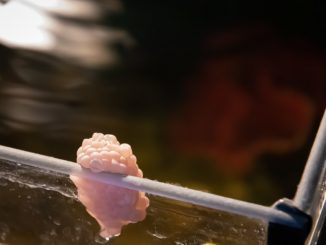
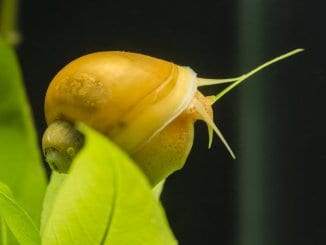
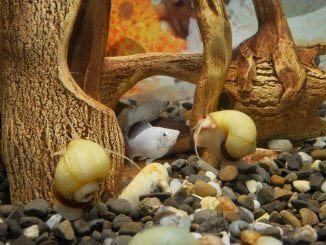
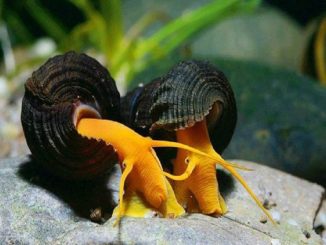
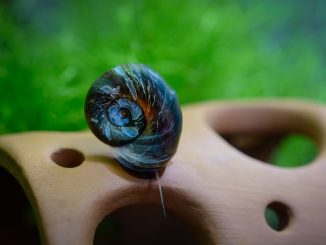
I originally bought only three or four snails to keep my 55 gallon fresh water aquarium clean. My one concern is the snails seem to reproduce rather rapidly. I’m wondering if this is normal. Is this a controllable thing. Will the snail population get out of hand? Anyone have some advice?
You can get some bottom dwellers which will eat the eggs as they’re laid such as cory cats. Robert
Loaches will eat snails if they become too much of a problem
You will not control it. Best you can do is not overfeed your community fish or other animals, so algae and detritus doesn’t accumulate. These are the snail’s food sources and less food will result in less reproduction. However, you will have to learn to love them as family now.
Control the amount of food you feed your fish. Excess food will support a larger population.
Hi. I’m pretty sure my horned nerites have parasites. How can I cure them?
Hello, what symptoms are you seeing? Thanks, Robert
I’ve had a tiger nerite snail for a good couple of months now. However, its foot is a little detached from the inside of the shell and it’s not moving. I can’t tell if it’s dead (because it doesn’t smell) or if it’s just sleeping. Any advice?
Hi Leah, how long has he been like that? If he hasn’t moved in over 48 hours I would say it’s most likely dead. Snails tend to have short and frequent sleep cycles. Thanks, Robert
We have baby snails in a freshwater tank that came from ONE Zebra snail that has been in our tank for 2-3 months. How is that possible???
Hi Jenny, is it possible the baby snails hitchhiked their way in on a plant? Thanks, Robert
Do snails need to be quarantined before you put them in your aquarium, like fish? Also, I have gravel in my tank. Will they be ok on that?
Hi Susanna, yes I would quarantine all animals and plants before adding them to your established setup. And they will be fine as long as it’s a fine grain gravel. Thanks, Robert
So we have a small fish tank for my son that is home to 2 blue mystery snails, 1 golden mystery snail, 1 nerite snail and around 7 fish. And I am pretty sure our nerite snail mated with the blue mystery snails and now we have a few babies. While snail watching a few weeks ago I noticed a new addition to the tank, a barely visible baby snail with a dark shell similar to the nerite. There have been other babies but all have been blue or clear looking like the mystery snails. Now the only ones I have seen laying eggs are the Blues. We have had our tank for a few months and not added anything recently, so there is no way the baby snail could have hitchhiked its way in. The baby is now about the size of a pinky nail and until recently had been the only one with a dark shell but yesterday we noticed a new tiny barely visible dark shelled baby snail riding one of the adults.
How small of a fish tank? Because that sounds like it could be overstocked. (Aquatic critters tend to need more water than most people expect, to safely dilute their waste to non-toxic levels between water changes).
Also, nerites and mystery snails can’t intervreed. Could it be a pond or ramshorn snail? They’re very common pest snails that hitchhike in on plants and other snails. They also breed asexually, so if you have one in there it can make many more.
I bought tank vegetation online and put it in a spare tank for quarantine. It turned out to be full of eggs because now I have a large amount of snails of various sizes and shapes. I enjoy watching them but don’t know what types they are or how to clean a snail only tank without killing invisible babies. Suggestions are appreciated, Thanks!
Most of the time if it came off a plant from online or a pet store and they don’t mention snail free they are most likely ramshorn snails.btw they breed like crazy and I know a lot of people who call them pests because they eat plants and breed like crazy.
Anyone who has too many snails here’s an easy way to control them; capture them by hand or in a net, crush them between thumb and forefinger or two spoons and then feed them to your fish. Fish will have a feeding frenzy for this fresh protein and calcium. I have a 30 gallon tank of Guppies and they go absolutely bonkers for their treats.
I have a newly set up 5.5 gal. planted Betta tank with eco complete substrate. Starting to get brown algae or diatoms. Will a Nerite eat this? Is the substrate I have too sharp for it? Or instead of a snail would an Otocinclus be a good option & again, would my substrate be too rough/sharp for it?
Hi Janice, I’d say it’s too rough for them. You could place a half inch layer of sand on the top. Thanks, Robert
I suggest getting a sand so they can’t cut themselves also their is a outer layer and soft layer of algae normally most snails eat the soft layer because the hard layer is to “hard”also I have a Otocinclus what happens is Otocinclus eat off your decorations rocks and services but a snail eats both. You can get both they wouldn’t mind each other you can get a Otocinclus at pet smart for 2.49 and a snail at pet smart for 2.99 so very cheap btw these live stock need filters\ bubbler .
I have a 25 gallon tank with 2 goldfish, and am interested in adding 2 or 3 nerite snails. Would they be safe from the goldfish?
Hi McKenzie, with them being slightly larger than the normal snail they will probably be OK, it’s not guaranteed though. Thanks, Robert
I’ve been trying to find out can Tiger nerite snails see light? Dark?
Hi Jennifer, it is thought that snails can tell the difference between light and dark, but we’re not sure as to the full extent that they can see. Let me know if you find out anymore! Thanks, Robert
Both Nerite and Mystery Snails supposedly have very poor eyesight but CAN distinguish light from dark. Often my Mystery snails will suddenly drop to the bottom of the tank when i turn on the tank light in a dark room. The light evidently startles them. Also watch how an aquarium filled with snails comes to life when the lights go out. Amazing!
Hello. My two nerite snails have been laying a lot of eggs and I was wondering if moving the eggs to brackish water would be enough for them to grow into snails. My plan was to put something like a terracotta pot into the aquarium, let the snails lay eggs on the pot, and move the pot to brackish water as soon as I notice new eggs. Do you think there’s a chance of that plan succeeding?
Wondering how you would move Nerite snail eggs?
I have a brackish water tank but my snails seem to be dying. All test show the levels to be where they should be. There is algae. I’ve smelled the snails and there is no strong odor to show them as dying but there has been no activity for 4 days. I have 5 zebra nerites in 125 gal setup. How long will they sleep? Am I correct to be concerned or will they wake up and get to work?
I have a single nerite snail in an aquarium with my ghost shrimp. Somehow, it laid eggs and the eggs hatched. How is this possible? Will the babies die because it is a freshwater aquarium?
So I had 2 weeks ago bought a Nerite snail as the other one had died. I’d also bought a couple of shrimp and a male guppy. I already have a yellow Inca snail in the tank. Well lo and behold, today I noticed I have an explosion of tiny snails in the tank. I stopped counting after 20. I don’t know what they are and where they came from. What do I do?
Thanks for any advice.
I have a 10 gallon tank with 4 male guppies two female platies, one algae eater two shrimp and two snails.
And I’m below an amateur; I’ve finally after almost a year of trying got an aquarium with fish that want to live in my ‘care’, and then this. ????. HELP.
Hi, I have a 3gal half moon Betta tank that I just set up. After it has a chance to get a little algae growing I would like to get a nerite snail. My betta is not particularly large, about 1.5inches probably. I was going to get 2 merited, but is sounds like I probably should only get 1? Also, I have regular plain old brightly colored aquarium gravel. I have ordered some much smoother little tumbled crystals (rose quartz and aquamarine) will those be ok for a nerite?
Hi hoping you can help. Please email if you need more detail. I’ve submitted video and pictures on several shrimp, snail and aquarium forums. I thought I had harmless rhadbacella worms (Sorry spelling) no triangle heads…in my shrimp tank. Cherry shrimp in a 10 gallon. Had not fed in days.
I placed a Nerite in after quarantining him and acclimating. They swarmed him and I fear they may be in his shell. How can I help him if it is planaria or someone else said snail leeches….. treating as if planaria with fenbendazole for today and hoping the Japanese treatment arrives soon. Please help me save this dang snail. I know he won’t go back in that tank for a long time but I can’t risk putting him in my son’s tank and infecting it as well.
One of my Nerites has something hard-looking sticking off its side, it just came up. It seems like it might be a damaged operculum – I’m not sure what to do? Anything? Do I just leave it alone and let the snail sort it out?
Hi I have 2 nerite snails in a 36 gal. I have all the escape routes blocked. What I am noticing is one nerite is staying under the hood out of the water I have moved him back into the aquarium and he is now back under the hood. It is notable that there is usually a bit of water that somehow accumulates there. Is this a problem and I need to check the environment or is he fine and will go back inside by himself? By the way the tank has plenty of algae the other one seems to like to eat it; I have only had them less than a month.
Hi can anyone answer this question i have nitrate snails in a 4 foot tank and they keep it super clean free from algae my question is why dont they eat the algae on the light ??
I am trying to keep marimo in a quart jar(my apartment isn’t large enough for a proper tank, unfortunately), but as expected now the sides are accumulating algae. Would a small nerite be ok in a jar with several marimo & regularly changed spring water?
I have a small tank with sea glass pebbles. Is that too rough for a red onion nerite?
What is the minimum amount of salt in the water to breed nerites?
My nerite appears to have a dark brown hairy fungus growing out of his shell.
Do you know what it is?
I have 2 horned Nerite snails, one is brown and the other is yellow and black striped. Both are about the size of a peanut. The striped one has been attached to the back of the brown one since they joined the tank (about 3-4 months). Should I pull them apart? Is the striped in eating the shell of the other? Is it okay for them to continue in this manner. They have never been apart.
Is a blue colord sand bottom good or bad for snails because I am looking to get 3 snails for my 25 gallon tank and it’s swarming with brown algae so would the snails be ok in there ??
I had a nerite snail that lived for just over 9 years.
We are looking after a nerite snail while the owners are currently overseas. Their house is cold with the heating set at 10C. The snail was found upside down having seemingly fell from an aquarium ornament. It has been turned over (upright) but hasn’t moved since. Could it be dead or hibernating or is the water is too cold?
Many thanks.